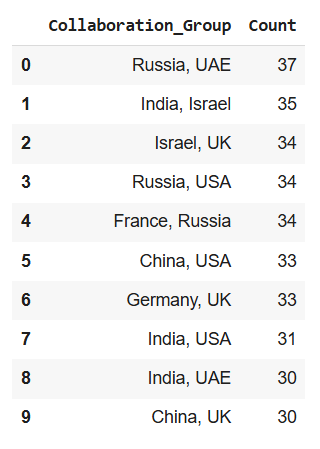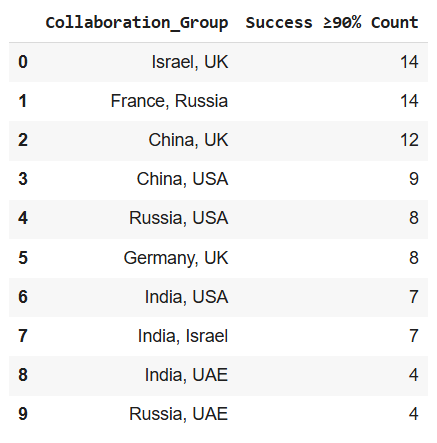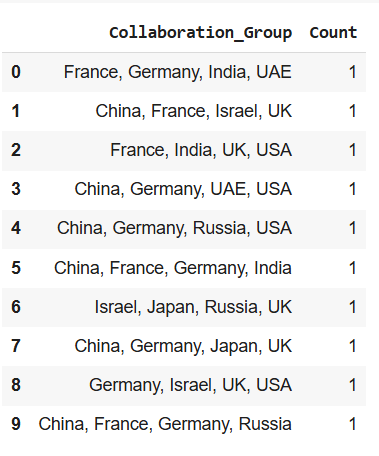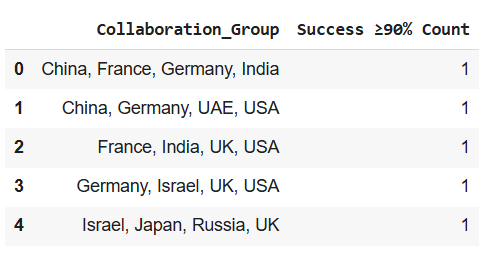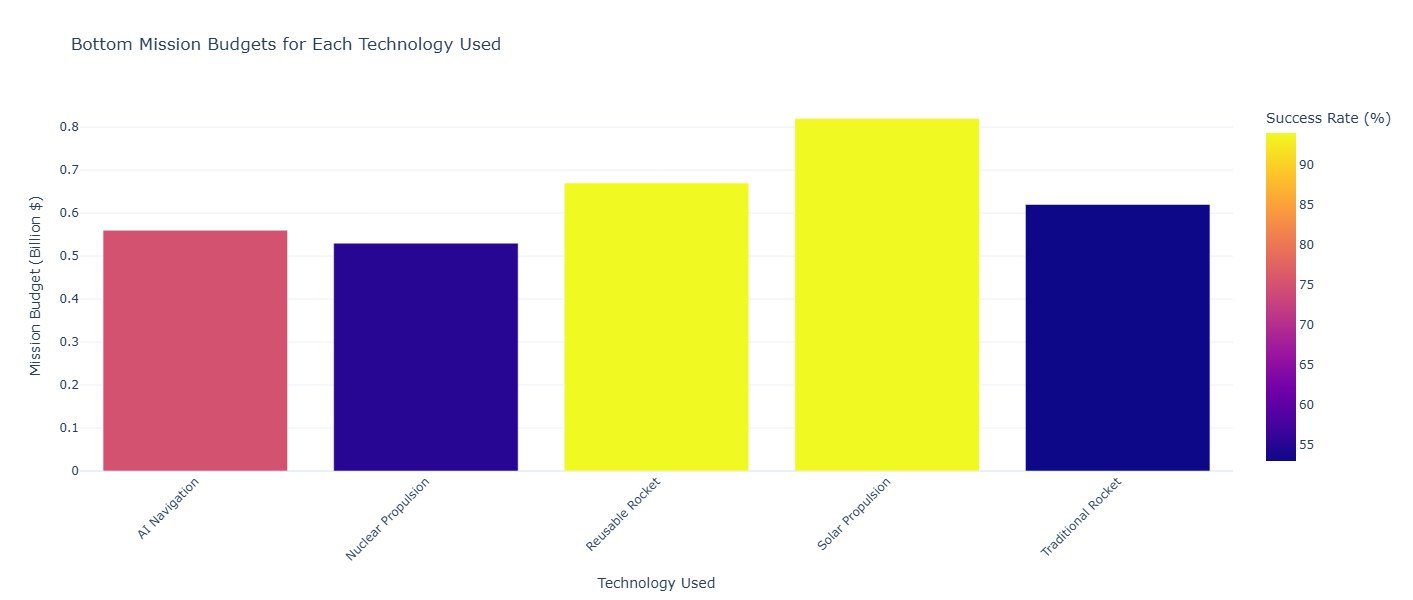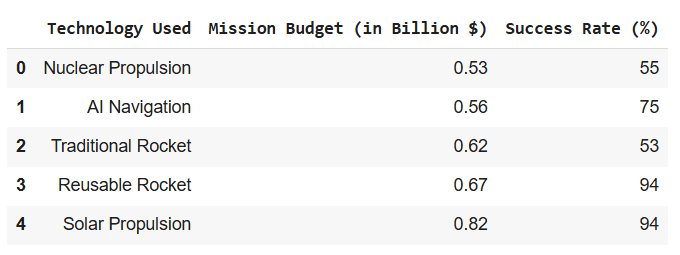
In space exploration, collaboration isn’t always a strength — without strategic alignment, it’s just expensive diplomacy.
25 Years of Space Exploration: Key Learnings & Future Paths
- May 3, 2025
- By Sagarika Chikhale
This project explores global space exploration missions from 2000 to 2025 using a dataset of 3,000 entries covering countries, mission types, budgets, technologies, success rates, and more. The goal is to identify trends, problems, and opportunities in international collaboration, technology use, budgeting, and environmental sustainability. The analysis focuses on four major challenges: ineffective collaboration strategies, budget mismatches, technology choices affecting environmental outcomes, and under-optimized satellite strategies. Through graphs, data comparisons, and success rate evaluations, the project uncovers key insights—such as the importance of strategic partnerships, the limited impact of high budgets alone, and the growing role of sustainable technologies. Based on these findings, five practical recommendations are proposed to help space agencies improve mission planning, funding decisions, and long-term performance. These recommendations are designed to guide data-driven, collaborative, and environmentally responsible space programs that align with future global priorities and deliver high value to all stakeholders involved in space exploration.
Not all collaborations lead to high success rates, what makes them effective?
The analysis of collaboration efficiency in space missions is essential to understanding what drives successful international partnerships. While collaborations generally enhance mission success, the data reveals that only strategic, well-aligned partnerships consistently achieve high outcomes. This insight is vital for space agencies aiming to optimize cooperation strategies. It emphasizes that collaboration alone is not enough—compatibility in technology, political alignment, and shared objectives play a critical role. Recognizing these factors can help stakeholders design more effective partnerships, reduce mission risks, and enhance returns on joint investments. This analysis informs future collaboration models that are both efficient and outcome focused.
Variation in Collaboration Engagement Across Countries
Countries like Germany, USA, and Russia have a higher number of missions involving international collaborations. In contrast, countries such as France, China, and India have been less active as collaborators, despite their high individual mission counts. This discrepancy raises questions about the strategic, financial, or geopolitical reasons influencing a nation’s decision to engage or abstain from collaboration in space missions.
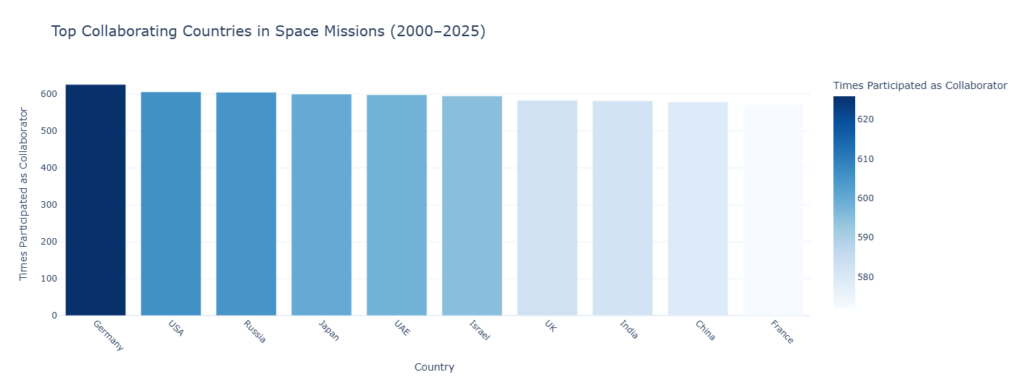
Bilateral Partnerships are More Common, but Not Always More Effective
According to the collaboration count distribution, missions involving one collaborating country (bilateral agreements) are the most frequent. Countries may prefer bilateral partnerships for simplicity and to increase strategic alignment.
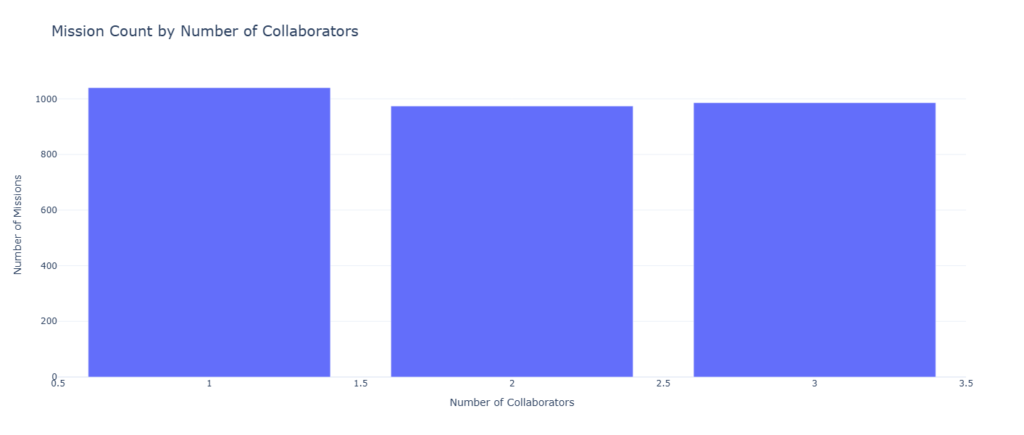
However, the success rate distribution for missions with 90%+ success rates reveals that collaborations involving more than one country (especially 2 or 3) often lead to higher mission performance. This suggests that shared expertise, resources, and risk in multilateral missions can contribute positively to mission outcomes, provided the collaboration is strategically aligned.

Collaboration Frequency Does Not Guarantee High Success
Insights from the frequency and success of country-pair collaborations show that frequent collaboration does not always equate to high performance. For example, although Russia–UAE and India–Israel were among the most frequent collaborators, their missions had lower instances of 90%+ success rates compared to less frequent but more effective partnerships like Israel–UK. This suggests that the effectiveness of collaboration depends more on strategic compatibility than frequency. However, it also important to note that success rate of space missions depends not only on country’s strategic partnership but also on budget, technology, human resources, external environment of rockets or satellites.
Least Frequent Collaborations Show Limited Success
Further, some combinations, such as China, France, Germany, and Russia, appeared only once in collaborative missions during the dataset range, with moderate success (~82%). While not conclusive due to limited data points, it emphasizes that infrequent or ad hoc collaborations may face challenges related to alignment, communication, or operational execution—potentially affecting mission outcomes.
Are countries overspending or underspending on certain technologies or satellite types?
The analysis and insights are crucial for guiding smarter financial decisions in space exploration. They highlight that success is not solely a function of how much is spent, but how effectively resources are allocated. By uncovering inconsistencies between budget levels and mission outcomes, the analysis encourages a shift from cost-heavy approaches to performance-driven investments. This is particularly valuable for agencies operating under financial constraints or seeking to optimize returns. The findings support the development of funding strategies that prioritize high-performing technologies and collaborations, ultimately leading to more efficient use of public and private space exploration budgets.
High Budgets Do Not Guarantee High Success Rates
From the analysis of top mission budgets by technology, it is observed that missions using similar high budgets (~49.9 billion dollars) do not necessarily achieve uniform success. For instance, technologies like reusable rockets and nuclear propulsion are associated with 90%+ success rates, while solar propulsion and traditional rockets, despite being funded at comparable levels, achieved significantly lower success rates (50% and 55% respectively). This indicates that funding alone does not drive outcomes—the effectiveness of technology itself plays a critical role.
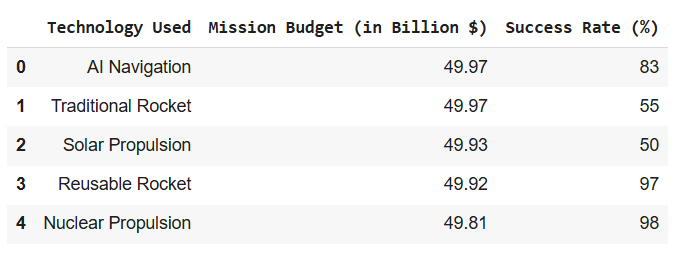
Low-Budget Missions Can Deliver High Performance
The analysis of the lowest mission budgets by technology reveals that reusable rocket technology achieved a 94% success rate at a budget of just 0.67 billion dollars, whereas traditional rockets, with a similar low budget (0.62 billion dollars), had a success rate of only 53%. This again confirms that certain technologies are inherently more reliable and efficient, delivering better results even with minimal financial investment.
Strategic Collaborations Amplify Budget Efficiency
Insights from demonstrate that the success of a mission is also influenced by the strategic choice of collaborators, not just the budget or technology. For example, India’s collaborations with UAE, USA, Japan, and Isreal resulted in higher success rates, even across varying budget levels. In contrast, Japan’s collaborations with Germany and China yielded only 50% success, and its broader collaboration group including UK, UAE, and India resulted in a 57% success rate. This highlights the importance of aligning technological investment with suitable international partners to achieve efficient outcomes.

Which technologies contribute most to high-impact missions?
The analysis and insights are critical for understanding the environmental implications of space missions. By examining the relationship between technology choices and environmental impact, the analysis highlights the importance of adopting sustainable technologies in space exploration. It challenges the assumption that high budgets alone ensure low environmental impact, showing that innovation in propulsion technologies plays a key role. These insights are vital for space agencies aiming to align their missions with global sustainability goals, guiding decision-makers to invest in cleaner, more environmentally responsible technologies and strategies for future missions.
Technology Has a Clear Link to Environmental Impact
As revealed in the following graph, missions utilizing traditional rockets between 2000 and 2024 were frequently associated with moderate to high environmental impact. In contrast, missions deploying newer technologies such as AI Navigation and Solar Propulsion predominantly led to low to moderate environmental impact. This indicates that technological advancement is playing a positive role in improving the environmental sustainability of space missions.
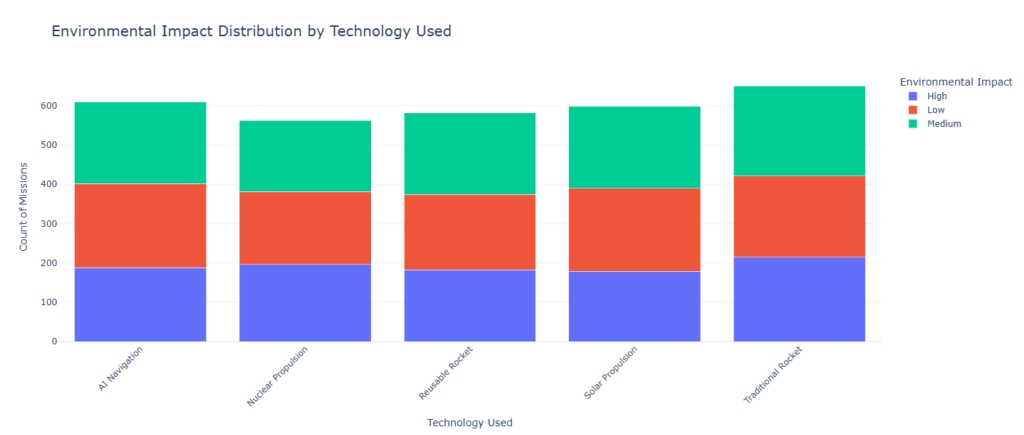
Satellite Type is Not a Major Driver of Environmental Outcomes
The association analysis using Cramér’s V value of 0.028 shows no significant correlation between satellite type and environmental impact. This suggests that the purpose or function of the satellite (e.g., communication, navigation, research) does not directly influence the environmental consequences of the mission. Technology used for propulsion and navigation, rather than satellite application, appears to be the more influential factor.
Mission Budget Does Not Determine Environmental Impact
With a correlation value of just 0.0079 between mission budget and environmental impact, the data suggests that spending more (or less) on a mission does not inherently lead to better environmental outcomes. High-impact missions are not necessarily expensive, and low-impact missions are not always the result of high investment. This further reinforces the role of technology over budget in determining environmental performance.
Recent Shift Toward Environmentally Conscious Technologies
As observed, missions carried out from 2021 to 2024 predominantly fall within the low to moderate environmental impact range. This trend reflects a recent, consistent move towards adopting more sustainable practices, possibly due to technological advancements, policy influence, or growing global awareness around space-related environmental concerns.
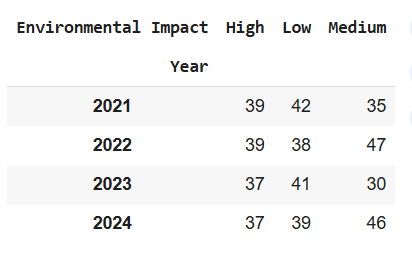
Satellite type trends vs. budget, success rate, and environmental impact?
The analysis and insights of are important because they reveal how satellite-type strategies may not be fully optimized in terms of budget allocation, mission outcomes, and environmental impact. Understanding these trends helps decision-makers identify which satellite types deliver the best return on investment and operational performance. This insight enables space agencies and stakeholders to re-evaluate their strategic focus, ensuring that resources are directed toward satellite categories that offer higher success rates and lower environmental risks. Such data-driven evaluation is essential for long-term planning, especially in an industry where mission costs are high and stakes are significant.
Investment Heavily Concentrated in Select Satellite Types
Countries have consistently directed the highest share of mission budgets towards Research and Weather satellite types, while Communication satellites received relatively lower investment. This suggests a clear prioritization pattern, possibly influenced by perceived strategic value or national interest in scientific advancement and climate monitoring.
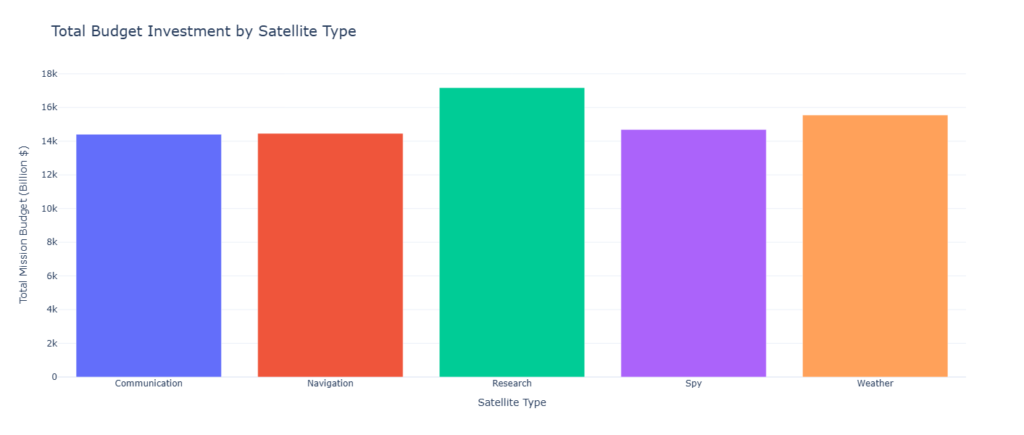
High Investment Does Not Always Equate to Optimal Performance
Research and Weather satellites not only received the most funding but also demonstrated strong mission success rates, particularly with a high number of missions achieving 90%+ success. In contrast, Navigation satellites—despite being essential for positioning and defense—showed fewer high-success missions, raising concerns about return on investment in that segment.

Potential Misalignment Between Funding and Mission Outcomes
The contrast between high-budget satellite types (like Research) delivering high success, and moderately funded or underperforming types (like Navigation), suggests a lack of strategic alignment between financial input and actual mission outcomes. This implies room for greater evaluation of satellite type effectiveness to ensure resources are being utilized optimally over time.
Next Steps:
• Prioritize Strategic Alignment in International Collaborations
Collaborations should not be pursued based solely on frequency or geopolitical convenience. Instead, space agencies must evaluate potential partners based on proven compatibility in mission success, technology alignment, and shared strategic goals. This ensures collaborations are outcome-driven, reducing inefficiencies and enhancing mission performance across all types of space initiatives. For example, the analysis of the following graph showing country-wise investment by satellite type indicates that Russia and the USA could be effective strategic partners for research missions. This potential is supported by their apparently aligned goals in this area, their possession of advanced technologies, and their long history in space missions. So, each agency can conduct partner assessments based on fixed criteria and validate potential collaboration partners before agreements are signed.
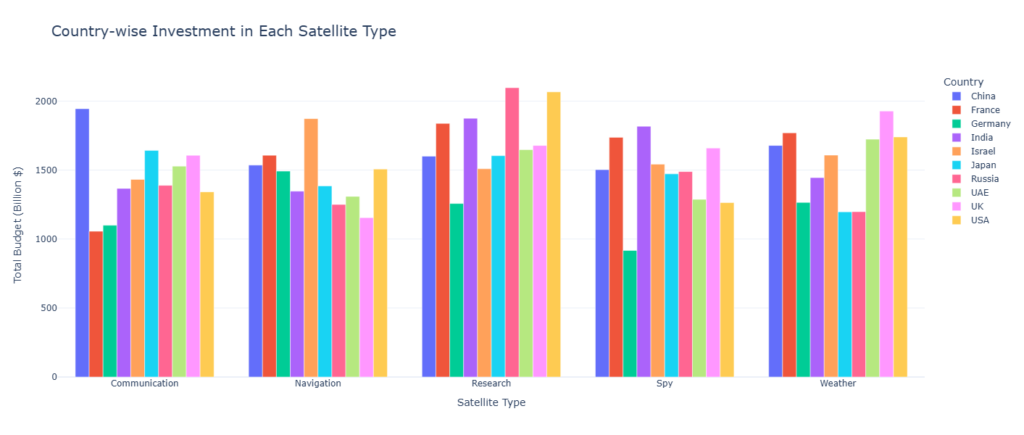
• Establish Integrated Mission Success Benchmarking Systems
Develop a unified benchmarking framework that evaluates missions across success rate, budget efficiency, environmental impact, and collaboration quality. This system should guide both internal and external stakeholders in making informed strategic decisions, helping align future space missions with best practices identified through data-driven insights. This can be achieved through creating an inter-agency benchmarking dashboard that standardizes data inputs and KPIs across missions, allowing agencies to consistently track, compare, and learn from each other’s performance outcomes. This can increase the efficiency of mission.
• Develop Technology Readiness and Suitability Index (TRSI)
Implement a standardized index to assess the maturity, efficiency, and contextual fit of technologies across mission types (e.g., reusable rockets for low Earth orbit, nuclear propulsion for deep space missions). This will help decision-makers select technologies not just based on trend or cost, but on proven adaptability and performance under specific mission conditions, optimizing both success and sustainability. By building upon existing frameworks like NASA’s Technology Readiness Levels (TRLs) and adding mission-context modifiers (e.g., environmental risk, payload sensitivity, duration) to form a multidimensional index used during the technology selection and procurement phases.
• Promote Multilateral Missions with Structured Governance Models
According to Pic et al., a large number of individual “one-on-one” collaborations can reshape the entire landscape more significantly than one big “group” agreement, however, in a negative way. Indeed, in the space industry, bilateral agreements can increase complexity and reduce trust between countries. Encourage multilateral collaborations by creating standardized governance frameworks that define roles, risk-sharing, data exchange, and accountability mechanisms. This reduces friction, increases trust, and enhances mission coordination, which is especially useful when more than two nations are involved and can improve both success rates and resource utilization. As this is a complicated part, to make it easier, implement a template-based governance charter (adaptable per mission) based on existing successful multilateral efforts like CERN. This ensures uniform expectations across legal, operational, and data-sharing domains for all involved countries.
• Integrate ESG (Environmental, Social, Governance) Principles into Space Mission Frameworks
Incorporating ESG (Environmental, Social, and Governance) principles into the planning, design, and approval stages of space missions can significantly enhance their sustainability and long-term impact. Prioritizing environmentally responsible technologies, ethical governance, and social considerations can not only mitigate negative ecological effects but also align space programs with global sustainability targets and international regulatory frameworks. By embracing ESG principles, space agencies can attract new funding opportunities from impact investors and enhance collaboration with countries and organizations committed to shared environmental and social goals, ultimately fostering more responsible space exploration and development.
These recommendations provide space agencies with a strategic roadmap for improving mission outcomes, sustainability, and collaboration efficiency. Prioritizing strategic alignment ensures partnerships are built on shared objectives and proven success. Benchmarking systems and the Technology Readiness and Suitability Index enable data-driven decision-making, maximizing ROI and minimizing risk. Promoting structured multilateral governance fosters trust and accountability in complex missions. Integrating ESG principles aligns space initiatives with global sustainability goals and unlocks new funding opportunities. Together, these actions help agencies streamline operations, enhance transparency, and ensure that investments in space exploration deliver both scientific and socio-environmental value over the long term.
Reference:
Pic, P., Evoy, P. and Morin, J.-F. (2023) ‘Outer Space as a Global Commons: An Empirical Study of Space Arrangements’, International Journal of the Commons, 17(1), p. 288–301. Available at: https://doi.org/10.5334/ijc.1271.

